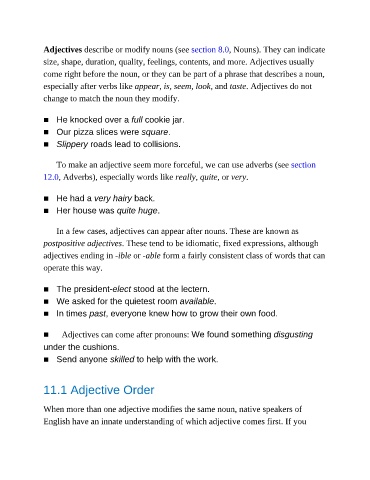Page 135 - Perfect English Grammar: The Indispensable Guide to Excellent Writing and Speaking
P. 135
Adjectives describe or modify nouns (see section 8.0, Nouns). They can indicate
size, shape, duration, quality, feelings, contents, and more. Adjectives usually
come right before the noun, or they can be part of a phrase that describes a noun,
especially after verbs like appear, is, seem, look, and taste. Adjectives do not
change to match the noun they modify.
■ He knocked over a full cookie jar.
■ Our pizza slices were square.
■ Slippery roads lead to collisions.
To make an adjective seem more forceful, we can use adverbs (see section
12.0, Adverbs), especially words like really, quite, or very.
■ He had a very hairy back.
■ Her house was quite huge.
In a few cases, adjectives can appear after nouns. These are known as
postpositive adjectives. These tend to be idiomatic, fixed expressions, although
adjectives ending in -ible or -able form a fairly consistent class of words that can
operate this way.
■ The president-elect stood at the lectern.
■ We asked for the quietest room available.
■ In times past, everyone knew how to grow their own food.
■ Adjectives can come after pronouns: We found something disgusting
under the cushions.
■ Send anyone skilled to help with the work.
11.1 Adjective Order
When more than one adjective modifies the same noun, native speakers of
English have an innate understanding of which adjective comes first. If you

